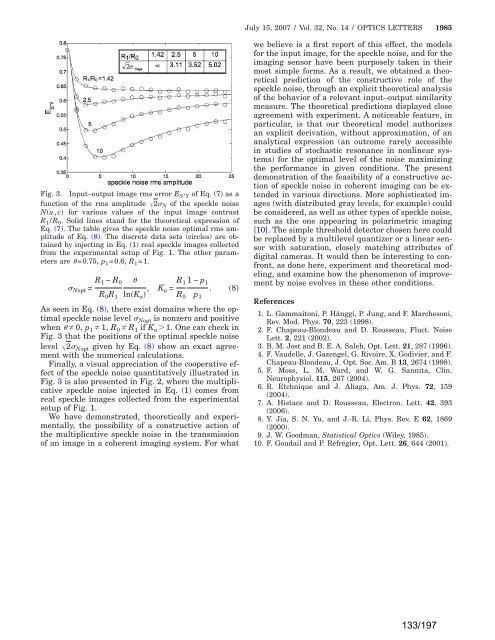a la physique de l'information - Lisa - Université d'Angers
a la physique de l'information - Lisa - Université d'Angers
a la physique de l'information - Lisa - Université d'Angers
Create successful ePaper yourself
Turn your PDF publications into a flip-book with our unique Google optimized e-Paper software.
Fig. 3. Input–output image rms error E SY of Eq. (7) as a<br />
function of the rms amplitu<strong>de</strong> 2 N of the speckle noise<br />
Nu,v for various values of the input image contrast<br />
R 1/R 0. Solid lines stand for the theoretical expression of<br />
Eq. (7). The table gives the speckle noise optimal rms amplitu<strong>de</strong><br />
of Eq. (8). The discrete data sets (circles) are obtained<br />
by injecting in Eq. (1) real speckle images collected<br />
from the experimental setup of Fig. 1. The other parameters<br />
are =0.75, p 1=0.6, R 1=1.<br />
Nopt = R 1 − R 0<br />
R 0R 1<br />
<br />
lnK a , K a = R 1<br />
R 0<br />
1−p 1<br />
p 1<br />
. 8<br />
As seen in Eq. (8), there exist domains where the optimal<br />
speckle noise level Nopt is nonzero and positive<br />
when 0, p 11, R 0R 1 if K a1. One can check in<br />
Fig. 3 that the positions of the optimal speckle noise<br />
level 2 Nopt given by Eq. (8) show an exact agreement<br />
with the numerical calcu<strong>la</strong>tions.<br />
Finally, a visual appreciation of the cooperative effect<br />
of the speckle noise quantitatively illustrated in<br />
Fig. 3 is also presented in Fig. 2, where the multiplicative<br />
speckle noise injected in Eq. (1) comes from<br />
real speckle images collected from the experimental<br />
setup of Fig. 1.<br />
We have <strong>de</strong>monstrated, theoretically and experimentally,<br />
the possibility of a constructive action of<br />
the multiplicative speckle noise in the transmission<br />
of an image in a coherent imaging system. For what<br />
July 15, 2007 / Vol. 32, No. 14 / OPTICS LETTERS 1985<br />
we believe is a first report of this effect, the mo<strong>de</strong>ls<br />
for the input image, for the speckle noise, and for the<br />
imaging sensor have been purposely taken in their<br />
most simple forms. As a result, we obtained a theoretical<br />
prediction of the constructive role of the<br />
speckle noise, through an explicit theoretical analysis<br />
of the behavior of a relevant input–output simi<strong>la</strong>rity<br />
measure. The theoretical predictions disp<strong>la</strong>yed close<br />
agreement with experiment. A noticeable feature, in<br />
particu<strong>la</strong>r, is that our theoretical mo<strong>de</strong>l authorizes<br />
an explicit <strong>de</strong>rivation, without approximation, of an<br />
analytical expression (an outcome rarely accessible<br />
in studies of stochastic resonance in nonlinear systems)<br />
for the optimal level of the noise maximizing<br />
the performance in given conditions. The present<br />
<strong>de</strong>monstration of the feasibility of a constructive action<br />
of speckle noise in coherent imaging can be exten<strong>de</strong>d<br />
in various directions. More sophisticated images<br />
(with distributed gray levels, for example) could<br />
be consi<strong>de</strong>red, as well as other types of speckle noise,<br />
such as the one appearing in po<strong>la</strong>rimetric imaging<br />
[10]. The simple threshold <strong>de</strong>tector chosen here could<br />
be rep<strong>la</strong>ced by a multilevel quantizer or a linear sensor<br />
with saturation, closely matching attributes of<br />
digital cameras. It would then be interesting to confront,<br />
as done here, experiment and theoretical mo<strong>de</strong>ling,<br />
and examine how the phenomenon of improvement<br />
by noise evolves in these other conditions.<br />
References<br />
1. L. Gammaitoni, P. Hänggi, P. Jung, and F. Marchesoni,<br />
Rev. Mod. Phys. 70, 223 (1998).<br />
2. F. Chapeau-Blon<strong>de</strong>au and D. Rousseau, Fluct. Noise<br />
Lett. 2, 221 (2002).<br />
3. B. M. Jost and B. E. A. Saleh, Opt. Lett. 21, 287 (1996).<br />
4. F. Vau<strong>de</strong>lle, J. Gazengel, G. Rivoire, X. Godivier, and F.<br />
Chapeau-Blon<strong>de</strong>au, J. Opt. Soc. Am. B 13, 2674 (1998).<br />
5. F. Moss, L. M. Ward, and W. G. Sannita, Clin.<br />
Neurophysiol. 115, 267 (2004).<br />
6. R. Etchnique and J. Aliaga, Am. J. Phys. 72, 159<br />
(2004).<br />
7. A. Histace and D. Rousseau, Electron. Lett. 42, 393<br />
(2006).<br />
8. Y. Jia, S. N. Yu, and J.-R. Li, Phys. Rev. E 62, 1869<br />
(2000).<br />
9. J. W. Goodman, Statistical Optics (Wiley, 1985).<br />
10. F. Goudail and P. Réfrégier, Opt. Lett. 26, 644 (2001).<br />
133/197


